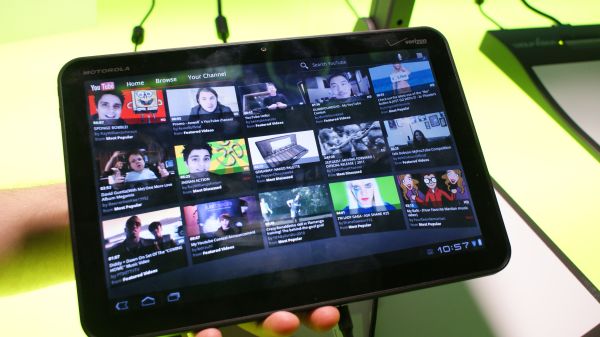Google Android 3.0 - Honeycomb Preview
by Saumitra Bhagwat on February 21, 2011 7:07 AM EST- Posted in
- Smartphones
- Honeycomb
- Android
- Mobile
Application Updates
Google has redesigned several of the core Android apps to take advantage of new UI elements like the Action Bar, hardware-accelerated graphics and of course the extra screen space. Apps like Music Player and YouTube have undergone some serious UI makeovers that really leverage the graphical prowess of the Renderscript graphics engine.

Just like on the iPad, Honeycomb brings a two pane UI to Email/Gmail. The app makes extensive use of the new Action Bar and “Fragments” framework to simplify workflows. Overall, the interface is clean and well organized.
Camera & Gallery

Froyo improved on the camera UI from Éclair (v2.1) by leaps and bounds; Honeycomb has taken it a step further and optimized it for two-handed operation on tablets. The new UI has a rotating dial-like interface that puts most important camera settings at your fingertips. The Gallery app has also been updated with a full-screen mode in addition to a thumbnail view of other pictures.
Browser
The browser on Honeycomb looks and feels a lot like Chrome. Its a serious upgrade to the stock Android browser found on earlier versions. Notable features include tabbed browsing, incognito mode, visual bookmarks, bookmark syncing and support for scalable vector graphics (SVG). SVG support was missing until now even though most mobile browsers like Opera Mini, Firefox Mobile and iOS Safari had supported it for a while. The Android browser has always shined performance-wise due to optimizations to JavaScript engine and the OS itself.
But a lot of the performance also depends on the underlying SoC. Google chose NVIDIA's Tegra 2 as the reference SoC for Honeycomb, so all of the initial Honecomb tablets will be based on NVIDIA's T20 SoC. For the latest benchmarks on Tegra 2 check out our Optimus 2X Review and Atrix 4G Preview.
Google Talk

The Google Talk app in Honeycomb (finally) adds support video conferencing. The interface is quite similar to the Gmail version of Google Talk. However, I’m more interested to see whether Honeycomb finally allows using multiple accounts with Google Talk. I was hoping Gingerbread would allow this, but alas I was proved wrong. The video conferencing interface is almost identical to how it’s handled in Gmail. Again, we’ll have more things to say as soon as we get our hands dirty with the Xoom.
Other Fixes

The keyboard has been slightly tweaked since Gingerbread and now includes a new “Tab” button. The keys have also been slightly modified for better placement and usability. The whole OS now supports multitouch gestures that are quite handy. Google has gone the extra mile to make sure that stock apps have a consistent and cohesive UI throughout. The OS now also adds a new UI for text selection, copy and paste that leverages the new Action Bar. Also included is an enhanced system-wide clipboard with drag and drop support that lets users copy, store and transfer content between parts of the OS and across applications. I’m sure there’ll be many minor tweaks and features scattered all over the OS, but we’ll have more on those in our detailed review soon enough.
Android Marketplace
The Marketplace app got a subtle facelift a few weeks ago, but was not updated with any new features in Gingerbread. The major announcement that came out of last week’s event was a web-based version of the Marketplace that you could browse from any computer. The website can also push purchased apps directly to your device within seconds. The other new feature is support for in-app purchases, which will be rolled out soon. Yet another example of the direction Google’s heading in with Android, tight integration with it’s own cloud services.
Developer Features
From a developer’s standpoint, Honeycomb features support for multiple cameras, multi-core processors, 2D/3D GPU acceleration across applications using the new Renderscript graphics engine, better compatibility across existing apps and so on. Also included is support for better multimedia and connectivity options like HTTP streaming, Media/Picture Transfer Protocol (MTP/PTP), a pluggable DRM framework to allow management of protected content regardless of the underlying DRM engine and API support for Bluetooth A2DP and HSP profiles. There are also some enhancements to the Enterprise feature set of the OS with policies for encrypted storage and password management.
Under The Hood Changes
Perhaps the biggest change in Honeycomb is that the Dalvik VM environment is now multi-core aware. This means the OS can now leverage the processing power and potential power savings of multi-core SoCs to speed things up and offer enhanced battery life. In fact, even single threaded apps can see speed improvements in Honeycomb. While running in a dual-core environment, the OS automatically lets the bytecode run on one core and the Dalvik garbage collector run on the other. Apps specifically written to support symmetric multiprocessing will see even larger performance gains. With companies like ARM (Cortex A15) and Qualcomm (Snapdragon “Krait”) already announcing their next-gen dual/quad-core SoC architectures, it will be exciting to see what kind of mobile performance we have in store for the future!











65 Comments
View All Comments
chomlee - Monday, February 21, 2011 - link
"Price is another issue if Honeycomb tablets need to stay competitive in the market. While more expensive tablet price points are tempting, a major strength of Android has been its ability to hit lower price points. For Honeycomb to be successful we need to see tablets priced at an iPad-competitive $499 in addition to the more expensive options we've been hearing about"I agree exactly. I would rather get a gingerbread tablet but if they are going to charge more than the IPAD, why would I risk "Trying" a different device when I know the IPAD runs great. I also think the 3G carriers need to be more flexible with the plans. There are alot of customers like myself that would like to enable the 3G one month here, and one month there (for vacations), but most carriers won't allow you to do that. Apparently, you can do that with the IPAD which is a huge plus (and it is relatively inexpensive).
medi01 - Monday, February 21, 2011 - link
Why? Let me guess:1) SD card slot
2) Folder support
3) Being able to read from / write to your tablet instead of syncing it with only one PC?
michael2k - Tuesday, February 22, 2011 - link
That costs $100?Shadowself - Monday, February 21, 2011 - link
"just the catalyst manufacturers need to come up with the next iPad-killer."The "next iPad-killer"? Has there been a first one *yet*?
NCM - Monday, February 21, 2011 - link
Just couldn't resist the "xxx-killer" cliché, could we?B3an - Monday, February 21, 2011 - link
@ Saumitra, nice first article.Regarding the next Android version 'icecream' you mention "we can be reasonably sure that many of the under-the-hood enhancements like an updated Dalvik VM, support for multi-core SoCs, 2D/3D hardware acceleration ... should make the cut."
But doesn't Android 2.3 not have this stuff already? It must atleast have some kind of multi-core support... whats the difference between support in 2.3 and 3.0?
I'm sure 2.3 also FINALLY now has UI GPU acceleration. Which has been one of the biggest problems with Android - laggy scrolling / animations. I hope to see a super smooth UI when i get the Galaxy S2.
Saumitra - Monday, February 21, 2011 - link
Glad you liked the article!1. Gingerbread might be able to see and recognize multi-core processors, but that's where the story ends. The Dalvik VM in Honeycomb actually divides tasks between cores, which Gingerbread doesn't support.
2. Gingerbread's UI only had partial hardware acceleration. That is, not all parts of the OS were being hardware accelerated.
jalexoid - Monday, February 21, 2011 - link
"Gingerbread might be able to see and recognize multi-core processors, but that's where the story ends. The Dalvik VM in Honeycomb actually divides tasks between cores, which Gingerbread doesn't support."That is incorrect. The major Dalvik VM improvement in 3.0 is that the VM can run the garbage collector in another thread. Ever since beta version Dalvik VM has supported SMP, if the kernel had that module enabled.
(Dalvik VM threads are directly mapped to pthreads. pthreads have supported multicore on ARM ever since the first ARM with multiple cores rolled down the manufacturing line and on other architectures since last century)
jrs77 - Monday, February 21, 2011 - link
Having seen the last weeks MWC there's no doubt that Google did alot of work with Honeycomb and it looks like it could actually give iOS a run for it's money.However, as you noticed there yourself, platform fragmentation will be yet again a killer for Android-based tablets as the experience simply will differ too much between all the devices.
That's the strong point of Apple and iOS, as they don't have to deal with this issue and have a consistent experience throughout all their devices.
mantrik00 - Monday, February 21, 2011 - link
There seems to be a confusion between differentiated UI (user experience) and platform fragmentation. For all the doomsayers like you, Android has been growing precisely because of this differentiated experience, which people who are hooked to Apple's ecosystem will never be able to fathom.